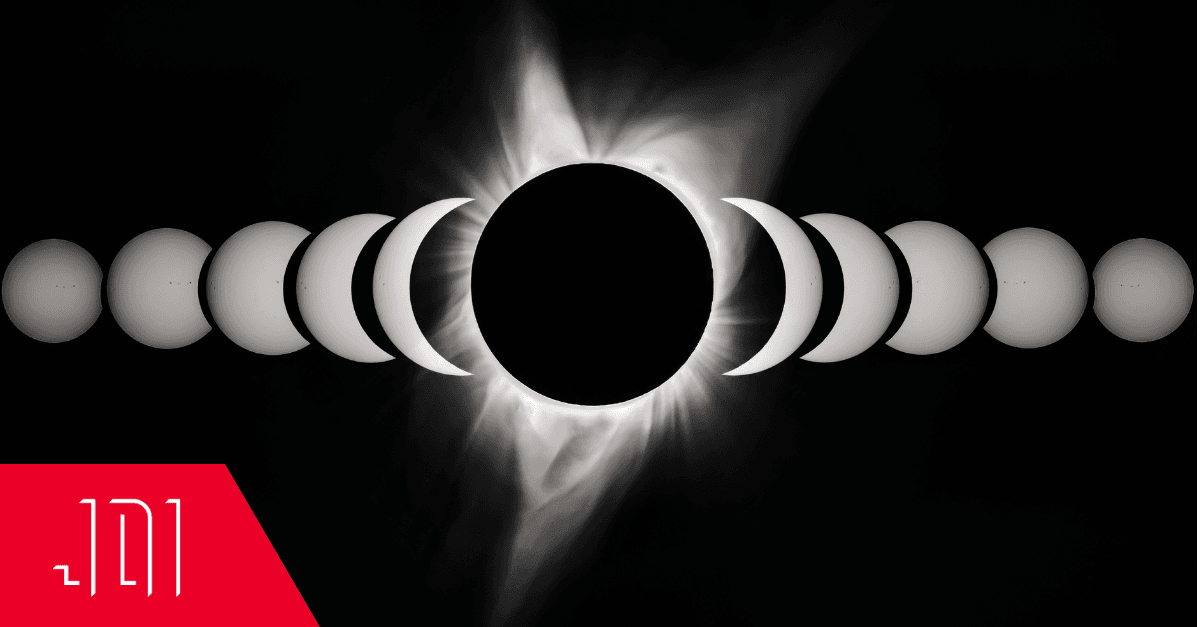Rabbit Hole: The Cosmic Coincidence of the Great American Eclipse
On April 8, a total solar eclipse will grace a large section of the U.S. While a solar eclipse itself isn’t necessarily a super rare occurrence, its visibility is limited to specific regions of the globe. Part of what makes this one so special is it’s the most accessible eclipse of our generation, according to Nicola Fox, associate administrator for NASA's Science Mission Directorate. Every state in the continental U.S. will see a partial eclipse, and there are roughly 3x as many people in the path of totality compared to the 2017 eclipse.
As the days count down, the hype is getting real – it will bring an estimated $1.4 billion to JDI's home state of Texas alone. Texas is also expecting a million travelers and has been declared a state of disaster because of traffic concerns. The next significant eclipse in the U.S. isn’t until August 2045, going from California to Florida. So, if you are fortunate enough to be in the path of totality, here are some reasons to totally nerd out during this cosmic event.
An eclipse is a cosmic coincidence
In simple terms, a total eclipse is a lineup of the sun, the moon, and Earth. The moon will be directly between the sun and the Earth, casting a shadow on the Earth. Totality (total eclipse) occurs when the moon covers the entirety of the sun except for the corona, or sun’s atmosphere. The sun and moon appear to be the same size from here on Earth because while the sun is 400 times bigger than the moon, the moon is approximately 400 times closer to us. This brief event reminds us of how amazing the universe is and how celestial bodies interact in fascinating ways.
Most people will never behold a total eclipse. Consider yourself lucky if you are in the 115 mile wide path of totality in Texas, Oklahoma, Arkansas, Missouri, Tennessee, Illinois, Kentucky, Indiana, Ohio, Michigan, Pennsylvania, New York, Vermont, New Hampshire, or Maine.
While total solar eclipses occur approximately every 18 months somewhere on Earth, the occurrence of a total eclipse visible from a specific location is of course much rarer. Since 2000, less than 10 percent of the world’s current population has passed through the umbra that the moon creates during totality – so while you can certainly travel and become an eclipse chaser, for most people, this is a once in a lifetime opportunity.
“Everyday things that we all might take for granted, such as the sun and the moon, become utterly surreal during an eclipse because we are suddenly reminded of how awesome they truly are.” – Dr. Andrew Hershberger, Art History Professor at Bowling Green State University
Live in the moment, or don’t. While NASA certainly wants you to enjoy the phenomena of the Great American Eclipse, they also wouldn’t mind if you were on your phone. Eclipses are learning opportunities for astronomers. For example, the minutes of totality provide us a rare opportunity to observe the sun’s corona, or outer atmosphere, which generally isn’t visible.
Anyone in the path of totality with a smartphone is invited to participate and download SunSketcher, “an app anyone can use to photograph the 2024 Great North American Eclipse. Mass participation will generate an incredible database of images that, when analyzed together, could allow scientists to map the Sun.” Like your eyes, make sure you use a protective filter over your camera, even if it’s the eclipse glasses.
NASA has volunteers lined up for the Eclipse Megamovie project as well. Within a singular point along the path of this eclipse, totality will endure for less than four and a half minutes, which is insufficient to observe the dynamic changes in the corona. NASA has strategically deployed photographers along the entire eclipse trajectory to prolong totality for more than 90 minutes – the duration required for the Moon's shadow to traverse from Mexico to Canada.
The captured images will be combined to make "movies," unveiling intricate corona activities that would otherwise remain elusive. It’s a pretty incredible way to inspire public interest in science.
Regardless of weather, it will still get dark! In a perfect world, there wouldn’t be a cloud in the sky on Monday, but it’s not looking promising. Despite the clouds, totality will be visible but some of the effect may be dulled. Most places see temperature drops of around 5 to 10 degrees Fahrenheit – the air temperature can drop more than 20 degrees F, as was reported in Gettysburg, Pennsylvania in the 1800s (who knows if that was actually accurate).
Take account of all your senses: the temperature will drop, you may see stars, and the animals will get quiet.
An umbrafile AKA eclipse chaser named David Baron, described the shadow effects from the eclipse: “If you look under a tree, the spaces between leaves or branches will act as pinhole projectors...There's another effect, which is as the sun goes from this big orb in the sky to something that's much, much smaller, shadows grow sharper. And so as you're nearing the total eclipse, if you have the sun behind you and you look at your shadow on the ground, you might see individual hairs on your head. It's just very odd.”
Stay safe. Solar glasses are a must. The only time you should take them off is during totality – otherwise, if you see any sliver of the sun’s disk, put them on. Even a few moments can cause permanent damage. What is scary is our retinas do not have pain receptors, so there is no way to register the damage in real time. After effects can be blurred vision and color distortion, so grab some from Amazon. Grocery stores like H-E-B are also selling them for $1.50.
“Everyday things that we all might take for granted, such as the sun and the moon, become utterly surreal during an eclipse because we are suddenly reminded of how awesome they truly are.” – Dr. Andrew Hershberger, art history professor at Bowling Green State University
In the midst of our hectic lives, this eclipse invites us to pause, gaze skyward, and to marvel at the beauty and intricacy of the cosmos. Let April 8 be a reminder of our place in the universe. Stay safe, and enjoy!




